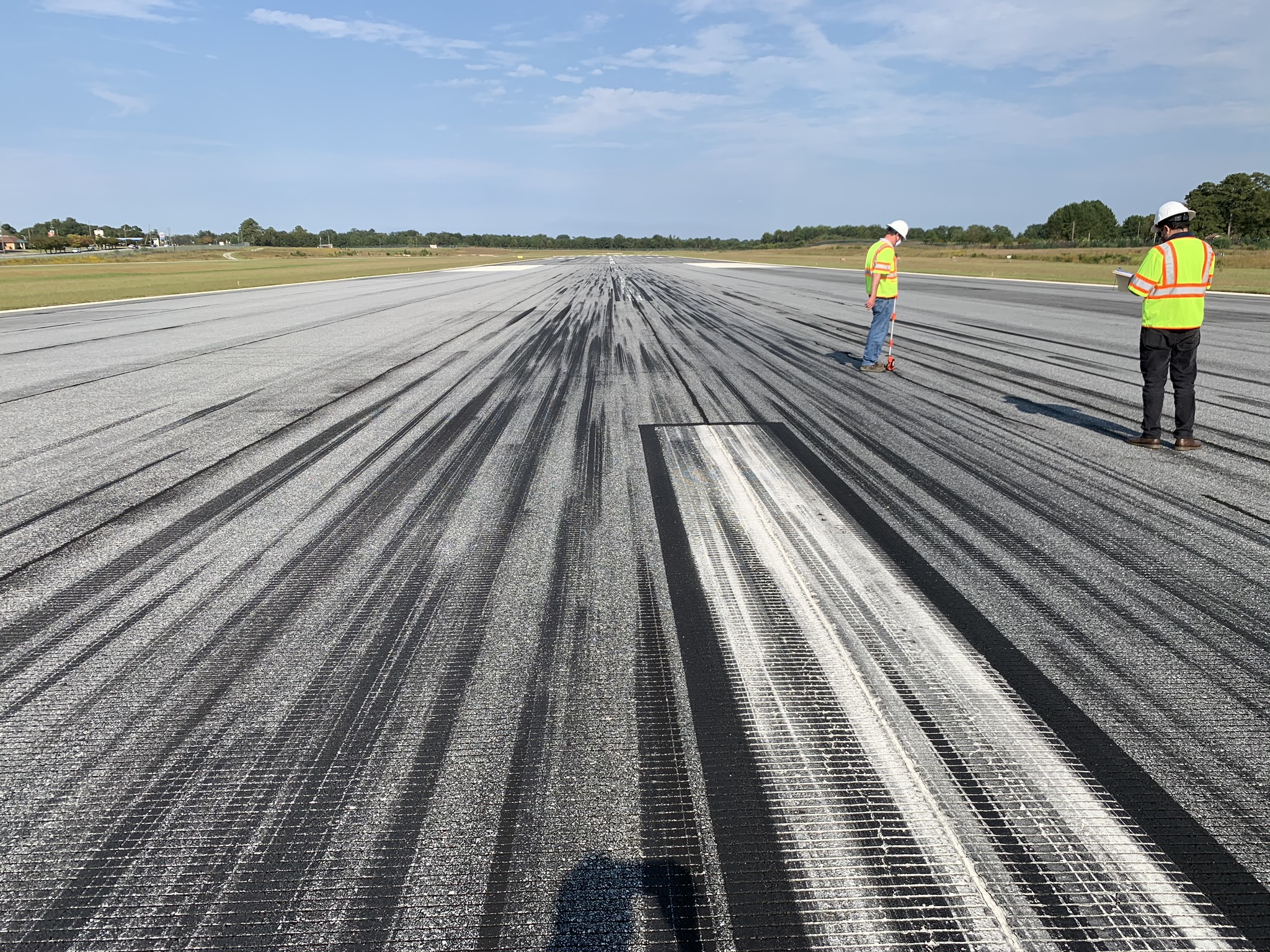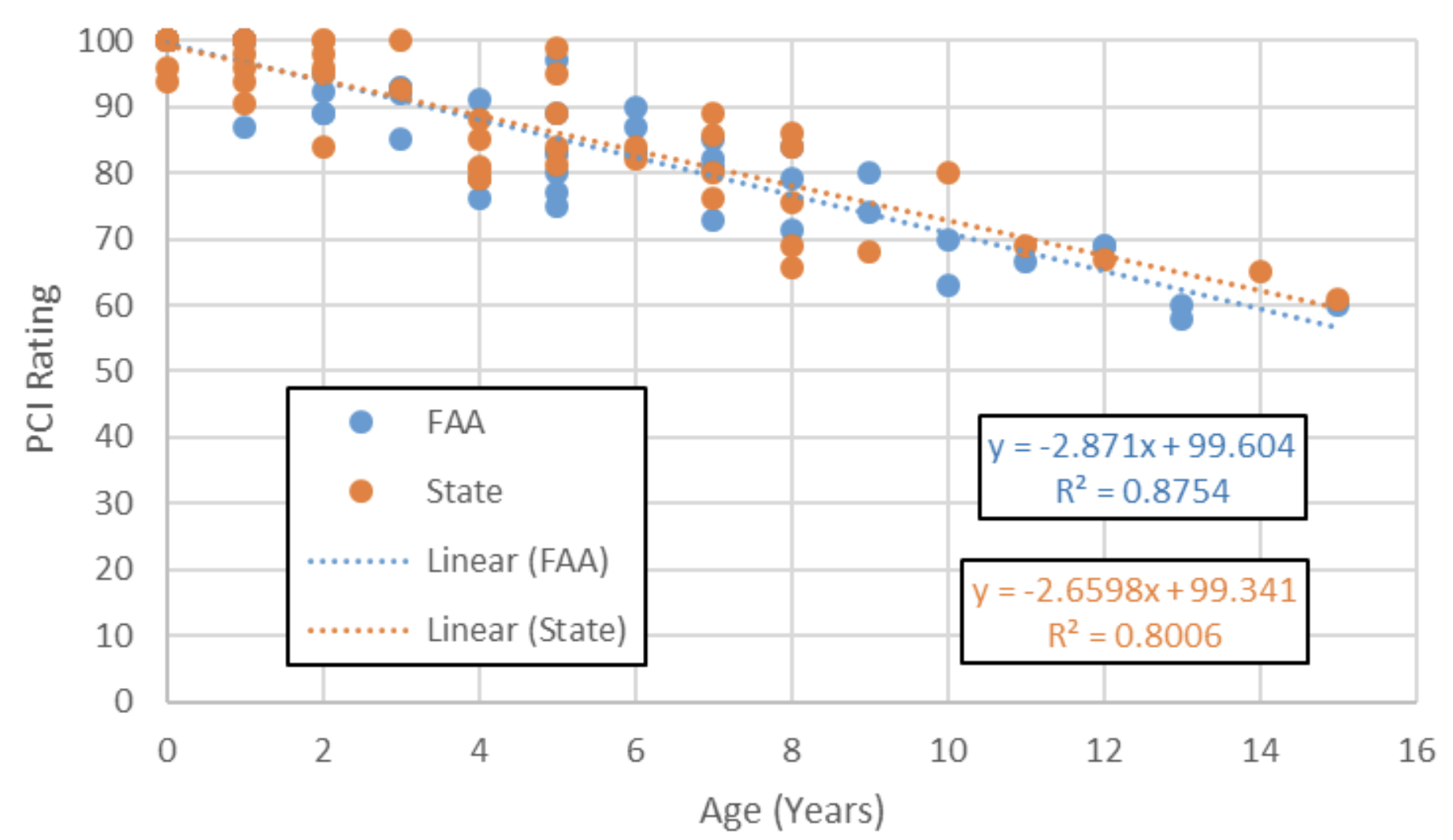- Spring 2022
In-Service Performance of Airport Asphalt Pavements Constructed with State Specifications

Jason Moore (left) and Fabricio Leiva (right) inspect the main runway at the Columbus, GA airport.
The Federal Aviation Administration (FAA) Reauthorization Act of 2018 initiated a requirement for the FAA to use highway materials specifications for pavements at non-primary airports (serving aircraft that do not exceed 60,000 pounds) if requested by the state. Due to significant differences in loading conditions between highways and airports, and since highway specifications were not developed for those conditions, the FAA asked NCAT to evaluate the performance of previously constructed airport asphalt pavements built using highway specifications compared to those constructed using traditional FAA specifications.
Information was collected and analyzed from 40 airport projects in five states to determine if there was a relationship between design, specifications, construction, and pavement performance. Twenty-one projects used FAA specifications and 19 used state highway specifications. A detailed review was also conducted of each specification, which focused on the requirements for aggregates, asphalt binder, mix design, quality control, acceptance, and construction.
Data from Pavement Condition Index (PCI) ratings were used to compare the performance of each project. Based on ASTM D5340 Standard Test Method for Airport Pavement Condition Index Surveys, PCI is a score (from 0 to 100) determined by a visual survey of pavement distresses. The data was obtained from pavement management reports provided by Applied Pavement Technologies Inc. The PCI ratings for each project were compiled and summarized based on the type of specification used (FAA vs. state). A plot of the data was then made of the PCI ratings by surface age for both FAA and state specifications, as shown in Figure 1.

Figure 1. PCI Rating vs. Age
PCI versus age for both types of specifications were fit with least-squares linear regression equations. Both regressions had a good fit with coefficients of determination (R2) of 0.87 and 0.80 for the FAA and the state data sets, respectively. An analysis of variance (ANOVA) of the data indicated that the type of specification used was not significant. The regression equations indicated a PCI rating of approximately 60 at year 14 for both types of specifications, which is considered to be “fair” condition based on the ASTM D5340 rating scale.
In order to determine if the type of specification impacted the types of distresses encountered, the percentage of distress deducts was summarized for each project. The distress deducts were characterized into three general categories:
- - Load-related: alligator cracking, corrugation, rutting, and shoving
- - Climate-related: block cracking, joint reflective cracking, longitudinal & transverse cracking, raveling, and weathering
- - Other: bleeding, depression, jet-blast erosion, oil spillage, polished aggregate, patching & utility cut patch, slippage cracking, and swell distress
For both types of specifications, climate-related distresses were the predominant mode of distress on all projects, with longitudinal and transverse cracking the most prevalent.
With regard to the review of the specifications, while the mat density requirements were similar for both state and FAA specifications, the FAA has a strict method specification for joint construction plus a joint density requirement, whereas the majority of the state specifications examined did not. Although it would be expected that the FAA joint specification would have improved longitudinal joint performance, the available data did not show better performance for longitudinal or transverse cracking.
One important item to note is that several of the state specifications used on airport projects in this study were not true “highway” specifications. Of the five states evaluated, three had separate aviation specifications that were used for airport construction. These specifications were generally a blend of FAA and the state’s highway specifications.
Based on this performance data analysis, no differences in pavement life were evident between airfield asphalt pavements constructed with FAA specifications and state specifications. This supports the continued use of state specifications for airfield asphalt pavements at non-primary airports serving aircraft that do not exceed 60,000 pounds— if requested by the state. However, additional guidance should be provided for airports using state specifications regarding the construction and acceptance of longitudinal joints.
Given the predominance of climate-related distresses on airfield asphalt pavements, further research is warranted on the selection of suitable mixture cracking and durability performance tests related to environmental distresses, and establishing criteria for the future use of the test (or tests) in FAA mix design and acceptance specifications.

For more information about this article, please contact Jim Musselman.